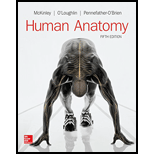
LooseLeaf for Human Anatomy
5th Edition
ISBN: 9781259285271
Author: Michael McKinley Dr., Valerie O'Loughlin, Elizabeth Pennefather-O'Brien
Publisher: McGraw-Hill Education
expand_more
expand_more
format_list_bulleted
Question
Chapter 5, Problem 5CR
Summary Introduction
To determine:
The three zones along the length of the hair.
Introduction:
Hair is derived from epidermis and is made up of two distinct parts: the follicle and the hair shaft. The follicle is responsible for anchoring each hair to the skin, and the hair shaft is formed from the hair bulb. It consists of a cortex and cuticle cells, and a medulla for some types of hair.
Expert Solution & Answer
Want to see the full answer?
Check out a sample textbook solution
Students have asked these similar questions
What is behavioral adapt
22. Which of the following mutant proteins is expected to have a dominant negative effect when over-
expressed in normal cells?
a. mutant PI3-kinase that lacks the SH2 domain but retains the kinase function
b. mutant Grb2 protein that cannot bind to RTK
c. mutant RTK that lacks the extracellular domain
d. mutant PDK that has the PH domain but lost the kinase function
e. all of the above
What is the label ?
Chapter 5 Solutions
LooseLeaf for Human Anatomy
Ch. 5 - What are the two major layers of the integument...Ch. 5 - Prob. 2WYLCh. 5 - Why is the stratum spinosum important in...Ch. 5 - Briefly describe the process of keratinization....Ch. 5 - Prob. 5WYLCh. 5 - How do melanocytes help protect the skin?Ch. 5 - Briefly describe the structure of epidermal ridges...Ch. 5 - What is indicated by the lines of cleavage in the...Ch. 5 - Prob. 9WYLCh. 5 - Prob. 10WYL
Ch. 5 - Why does the lunula of the nail have a whitish...Ch. 5 - Prob. 12WYLCh. 5 - Compare and contrast merocrine and apocrine sweat...Ch. 5 - What do sebaceous glands secrete?Ch. 5 - What is the source of new epidermal cells and new...Ch. 5 - Why do skin repair processes take longer as we...Ch. 5 - What is the cause of increased sensitivity to the...Ch. 5 - Match each numbered item with the most closely...Ch. 5 - Prob. 1MCCh. 5 - Prob. 2MCCh. 5 - The sweat glands that communicate with skin...Ch. 5 - Which of the following is not a function of the...Ch. 5 - Prob. 5MCCh. 5 - Which statement is true about melanin and...Ch. 5 - Prob. 7MCCh. 5 - Prob. 8MCCh. 5 - Prob. 9MCCh. 5 - Water loss due to evaporation of interstitial...Ch. 5 - Prob. 1CRCh. 5 - Describe two ways in which the skin helps regulate...Ch. 5 - Prob. 3CRCh. 5 - Prob. 4CRCh. 5 - Prob. 5CRCh. 5 - Prob. 6CRCh. 5 - Describe how the skin is involved in vitamin D...Ch. 5 - Prob. 8CRCh. 5 - Prob. 9CRCh. 5 - Prob. 10CRCh. 5 - Prob. 1DCRCh. 5 - Prob. 2DCRCh. 5 - Prob. 3DCR
Knowledge Booster
Learn more about
Need a deep-dive on the concept behind this application? Look no further. Learn more about this topic, biology and related others by exploring similar questions and additional content below.Similar questions
- Can you described the image? Can you explain the question as well their answer and how to get to an answer to an problem like this?arrow_forwardglg 112 mid unit assignment Identifying melting processesarrow_forwardGive only the mode of inheritance consistent with all three pedigrees and only two reasons that support this, nothing more, (it shouldn't take too long)arrow_forward
- Oarrow_forwardDescribe the principle of homeostasis.arrow_forwardExplain how the hormones of the glands listed below travel around the body to target organs and tissues : Pituitary gland Hypothalamus Thyroid Parathyroid Adrenal Pineal Pancreas(islets of langerhans) Gonads (testes and ovaries) Placentaarrow_forward
- What are the functions of the hormones produced in the glands listed below: Pituitary gland Hypothalamus Thyroid Parathyroid Adrenal Pineal Pancreas(islets of langerhans) Gonads (testes and ovaries) Placentaarrow_forwardDescribe the hormones produced in the glands listed below: Pituitary gland Hypothalamus Thyroid Parathyroid Adrenal Pineal Pancreas(islets of langerhans) Gonads (testes and ovaries) Placentaarrow_forwardPlease help me calculate drug dosage from the following information: Patient weight: 35 pounds, so 15.9 kilograms (got this by dividing 35 pounds by 2.2 kilograms) Drug dose: 0.05mg/kg Drug concentration: 2mg/mLarrow_forward
- A 25-year-old woman presents to the emergency department with a 2-day history of fever, chills, severe headache, and confusion. She recently returned from a trip to sub-Saharan Africa, where she did not take malaria prophylaxis. On examination, she is febrile (39.8°C/103.6°F) and hypotensive. Laboratory studies reveal hemoglobin of 8.0 g/dL, platelet count of 50,000/μL, and evidence of hemoglobinuria. A peripheral blood smear shows ring forms and banana-shaped gametocytes. Which of the following Plasmodium species is most likely responsible for her severe symptoms? A. Plasmodium vivax B. Plasmodium ovale C. Plasmodium malariae D. Plasmodium falciparumarrow_forwardStandard Concentration (caffeine) mg/L Absorbance Reading 10 0.322 20 0.697 40 1.535 60 2.520 80 3.100arrow_forwardPlease draw in the missing answer, thank youarrow_forward
arrow_back_ios
SEE MORE QUESTIONS
arrow_forward_ios
Recommended textbooks for you
 Anatomy & PhysiologyBiologyISBN:9781938168130Author:Kelly A. Young, James A. Wise, Peter DeSaix, Dean H. Kruse, Brandon Poe, Eddie Johnson, Jody E. Johnson, Oksana Korol, J. Gordon Betts, Mark WomblePublisher:OpenStax College
Anatomy & PhysiologyBiologyISBN:9781938168130Author:Kelly A. Young, James A. Wise, Peter DeSaix, Dean H. Kruse, Brandon Poe, Eddie Johnson, Jody E. Johnson, Oksana Korol, J. Gordon Betts, Mark WomblePublisher:OpenStax College Human Physiology: From Cells to Systems (MindTap ...BiologyISBN:9781285866932Author:Lauralee SherwoodPublisher:Cengage Learning
Human Physiology: From Cells to Systems (MindTap ...BiologyISBN:9781285866932Author:Lauralee SherwoodPublisher:Cengage Learning




Anatomy & Physiology
Biology
ISBN:9781938168130
Author:Kelly A. Young, James A. Wise, Peter DeSaix, Dean H. Kruse, Brandon Poe, Eddie Johnson, Jody E. Johnson, Oksana Korol, J. Gordon Betts, Mark Womble
Publisher:OpenStax College


Human Physiology: From Cells to Systems (MindTap ...
Biology
ISBN:9781285866932
Author:Lauralee Sherwood
Publisher:Cengage Learning
The Integumentary System, Part 1 - Skin Deep: Crash Course Anatomy & Physiology #6; Author: CrashCourse;https://www.youtube.com/watch?v=Orumw-PyNjw;License: Standard youtube license